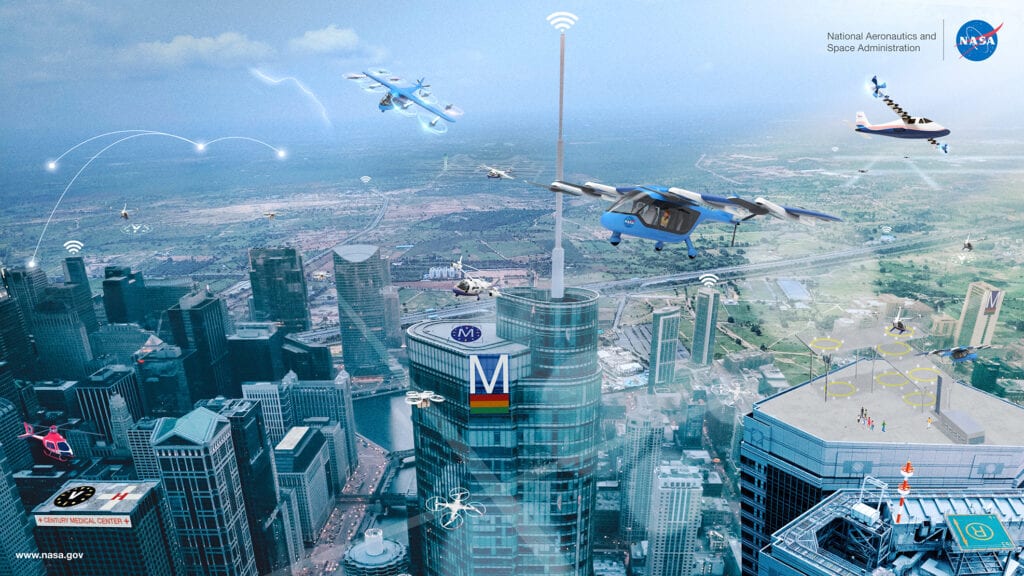
NASA’s AAM NC project is a collaboration between the agency, industry, and the Federal Aviation Administration (FAA). It is funded through 2030 and every two years the campaign gets more complex in operations. (NASA)
National Aeronautics and Space Administration (NASA) will be testing with Joby Aviation in the coming months as a part of its Advanced Air Mobility (AAM) National Campaign (NC). In preparation for these flights, NASA is creating a blueprint for its flight plan using a Bell OH-58C Kiowa helicopter to simulate the hurdles AAM vehicles will face, according to the agency.
“We need a vehicle that has a vertical lift capability to test our flight test plan and that flight test plan is basically the blueprint of moving forward with our vehicle partners,” Starr Ginn, NASA AAM NC lead, told Aviation Today. “It’s to tease out what are going to be even some certification hurdles for the vehicles because the whole airspace architecture and infrastructure is built around the performance of the vehicle and so you got to come up with some minimum safety standard.”
NASA’s AAM NC project is a collaboration between the agency, industry, and the Federal Aviation Administration (FAA). It is funded through 2030 and every two years the campaign gets more complex in operations Ginn said.

A Bell OH-58C Kiowa helicopter provided by Flight Research Inc. in Mojave, California, flies at NASA’s Armstrong Flight Research Center in California the first week of December 2020. The Advanced Air Mobility National Campaign project used the helicopter as a surrogate urban air mobility vehicle to develop a data baseline for future flight testing. (NASA)
“It’s a crawl, walk, run with the FAA,” Ginn said. “So our motto on the project is to anchor and evolve with the current FAA standards. So right now we’re assessing if I want to build a UTM route and procedure at an existing airport today, how would do that, and understanding what the current standards are and then already starting to give the FAA basic gaps…We just identify gaps for them and they’re there they’re in charge of changing standards and policy.”
NASA is testing UAM task elements that address the gaps in FAA standards that are presented with this new technology.
“There’s things today in the standards that don’t speak to electric airplanes, right,” Ginn said. “My example I always give people in Part 33 is endurance testing for piston engines, and when you read that and you look at doing a motor propeller test you’re like one of these things doesn’t look like the other. So you have to understand the logic that went into that procedure but you have to come up with very different language.”
NASA is currently working on how to understand how much reserves these vehicles will be required to have, Ginn said. These will differ from traditional aircraft because of the size and range of AAM vehicles.
They are also working on terminal operations in which they are looking at steeper angle approaches for AAM aircraft to avoid obstacles.
“We’re trying to understand when you do place these in an urban environment there is going to be obstacles, tall obstacles, to avoid,” Ginn said. “So we’re looking at much steeper angle approaches but trying to also take into consideration pilot comfort. Monitoring the G’s that we’re maneuvering, doing our maneuvers at the bank angles, or how far is the initial approach fix to the final approach fix, and how much does the airplane have the bank to get there. It’s balancing vehicle performance and making sure you still have enough control margin and passenger comfort.”
AAM vehicles may be unmanned at one point so NASA is also doing testing with command and control links, Ginn said.
“The command and control link is very critical and these vehicles are going to have to have something very similar to that,” Ginn said. “An uplink and a downlink because they’re relying on situational awareness from this airspace system. How are we going to get what is the going to be the solution for that and there’s all these questions about what kind of spectrum are you going to use and can it scale to 1,000s of these vehicles.”
Currently, these tests have to all be done manually, Ginn said. Once the tests progress further automation will become a factor.
“The complexity comes in the level of automation that that needs to be applied to both the vehicle and the airspace system,” Ginn said.
In 2021 NASA will also be announcing more partners and collaborations for this project, Ginn said. They will be continuing to do test flights for these partnerships based on the readiness levels of their technologies.
“By the end of calendar year ‘21, we should be well in, it just depends on the readiness level of their technologies,” Ginn said. “What we’re realizing is everybody’s just at a different readiness level…We have all of ‘22 to be testing the entire calendar year. 2022 is kind of when NC-1 is supposed to be but what our team has been super adaptable to when people are ready and getting them ready.”